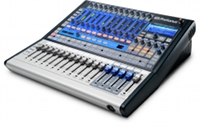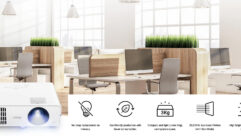

PreSonus StudioLive 16.0.2 Mixer
Nov 21, 2011 11:34 AM,
by John McJunkin
A small mixer that leverages remote control via computer.
PreSonus StudioLive 16.0.2 Mixer
I have been a user of PreSonus audio interfaces for quite some time, and I’ve always been very happy with their quality. I remember being excited a while back hearing that PreSonus would be offering a mixer—the company’s interfaces continued to get more and more sophisticated, and a mixer was a logical next step for them. When its StudioLive 16.4.2 mixer was introduced, I got to spend some time with it, and I was definitely impressed. A Grammy award-winning friend of mine has since acquired a StudioLive 24.4.2, and he absolutely loves it. I eventually became aware of PreSonus’ smallest mixer, the 16.0.2, and I recognized that in order to reduce the physical footprint of the mixer as small as the company did—and to reduce the price as much as it did—that the 16.0.2 would simply have to be a less robust mixer. I was happy to have the opportunity to evaluate one in order to satisfy my curiosity about what changes were necessary to arrive at a smaller, more budget-conscious mixer.
I was aware that the StudioLive 16.0.2 was small, but when the box arrived on my doorstep, I was a bit surprised. I pulled the mixer out of its retail packaging, and picked it up and examined it from all angles. It’s really small! But in the process of examining the user interface on the front panel, it began to dawn on me that despite its miniscule space requirement, there was quite a bit to this mixer. Some of the space-saving conventions were completely expected—60mm faders and navigation buttons that change the function of certain controls and displays. It lacks some of the metering of the 16.4.2 and feels a little more crowded, but I was still very optimistic that this mixer would prove to pack some power despite its size. One convention that supported my optimism is the capacity to control the mixer with a computer, and even an iPad. While a physical control surface may be constrained by size limitations, a graphical user interface on a computer can overcome such constraints with conventions that are familiar to most of us who use computers (which is indeed most of us)!
The lower 40 percent or so of the 16.0.2’s front panel is all about faders—17 of them to be exact. The first eight determine level of channels 1 through 8; the next four determine level for four additional mono mic inputs or four stereo pairs of line-level inputs. A bank of four faders represents master level controls for each of four auxiliaries, and a single “main” fader represents the overall output of the mixer. Above the faders are channel selection buttons, controlling functions like muting/soloing, linking, etc. Above that are the multimode buttons—mute, solo, and FireWire return—and also the mixer’s select buttons, which link channels and activate the mixer’s “fat channel” processing. The fat channel section is above these buttons, and it has all the EQ, dynamics, input, and panning controls for whichever channel is selected. I’m very accustomed to mixing this way—selecting a channel, making an adjustment, then proceeding to others as necessary. When digital mixers first arrived, many old school engineers objected to the notion of not having a complete bank of knobs, buttons, and faders for each and every channel. I suppose there is still a handful of them out there, but in 2011, most of them have learned to mix on both kinds of consoles, and are happy and conversant with both. This is one of the compromises that are necessary to squeeze a lot of power into a small console, and I believe most agree it’s worthwhile. In addition to these controls, there is a monitor section, controls for the system and digital signal processors, and an LCD display to present information about signal routing, processing, and so forth.
The 16.0.2 appears to sport four auxiliaries, but there are actually two more than that. The four that are represented by four master level faders facilitate getting a signal outside the mixer, most likely for monitoring purposes, but there are two additional auxiliaries that are permanently routed to the mixer’s two internal digital signal processors. If you really need additional signal processing, you can use the four external auxiliaries for that purpose. Another very powerful signal routing convention of the 16.0.2 is the capacity to route 16 channels of audio to and from a computer via FireWire. Obviously, the capacity to send multiple channels to the computer is intended to facilitate recording. The return path facilitates mixing what you’ve recorded. There are at least two other clever uses of this convention: the use of signal processing plug-ins within your computer and virtual sound-checking, in which you would record a performance with the intention of using it in place of the actual performers or professionals that will appear, buttoning down a baseline mix, and only needing to tweak input gains upon the arrival of the talent. When using your computer’s plug-ins as effects processors, the latency introduced by the round-trip of the signal through the processor needs to be considered, but the latency shouldn’t have a profoundly negative effect on most processing.
The inclusion of digital effects in small digital mixers appears to be nearly universal now, and the 16.0.2 is no exception. The two processors make 50 factory presets available—all reverbs and delays, exactly the kind of effects one might want for live use, and that’s where the onboard effects are likely to be employed. I wouldn’t mind seeing a handful of modulation-type effects here too, but I can live without them. Remember that the FireWire gives us access to effects in the computer, and that really increases the horsepower of the system. I really like the way these reverbs sound. The mixer’s EQs sound great and are clearly modeled on real analog equalizers. I cranked gain with a narrow Q and swept across the range of the mids, and got real resonance good modeling. The dynamics processors also sound good; the compression can be transparent if you like, but it can be pushed to get dramatic too. The graphic equalizer is a useful addition as well; it can be inserted on the main
PreSonus StudioLive 16.0.2 Mixer
Nov 21, 2011 11:34 AM,
by John McJunkin
A small mixer that leverages remote control via computer.
output to refine the overall spectral content of the final mix. It’s a 1/3-octave equalizer, but its resemblance to standard graphic EQs ends there. It employs a very sophisticated “curve-fitting” process that changes bandwidth and takes into consideration the boost or cut of the adjacent band.
As I said earlier, limitations of a user interface restricted by physical space can be overcome by a remote control graphical user interface on a computer, and PreSonus leveraged this and got it right. Its Universal Control application allows control of the mixer from both Mac and Windows computers, and I was tickled to see that an iPad can be used to control the mixer as well. This facilitates walking a room to micro-tweak EQs, among other things, or grabbing faders in the case of feedback even if you’re nowhere near the mixer—very powerful stuff. PreSonus has very thoroughly integrated computers into the system with a couple of applications aside from just remote control. Capture is a recording app that facilitates recording whatever’s happening on the mixer with just two clicks. Studio One is a full-featured DAW that allows the user to edit and mix any multitrack recording. I’m familiar with the original version of Studio One, but version 2 has been released recently, and it is vastly more sophisticated and powerful.
It’s abundantly clear to me that PreSonus’ developers sat down and really thought through the creation and implementation of this mixer. They compromised where necessary, but they poured a lot of horsepower into the mixer elsewhere. The integration with computers (and iPads) is particularly robust, and this adds even more functionality to the system. Considering the price and the performance, I can strongly recommend that you take a look at it if you need a powerful but small mixer for almost any application.
John McJunkin is the principal of Avalon Podcasting in Chandler, Ariz. He has consulted in the development of studios and installations and provides high-quality podcast-production services.
Product Summary
- Company: PreSonus
www.presonus.com - Product: StudioLive 16.0.2 Mixer
- Pros: Substantial horsepower considering tiny footprint and price.
- Cons: Fat Channel rotary encoders can be a little confusing at first.
- Applications: Boardroom, corporate, convention, hotel AV, theater, portable system
- Price: $1,599
Specifications
Microphone Preamp
- Frequency response to main output: 20Hz–20kHz, ±0.5dBu
- Input impedance: 1kΩ
- THD to main output: <0.005%, +4dBu, 20Hz–20kHz
- EIN to direct output: +125dB unweighted, +130dB A-weighted
- S/N ratio to main output: -94dB, +4dB, 20kHz BW, A-wtd
- Common mode rejection ratio: +65dB, 1kHz at unity gain
- Gain control range: (± 1dB) -16dB to +67dB
- Maximum input level: +16dBu (unity gain)
- Phantom power: +48VDC (± 2VDC)
Line Inputs, Balanced
- Frequency response to main outputs: 20Hz-20kHz, 0/-0.5 dBu
- Input impedance: 10kΩ
- THD to main output: <0.005%, +4 dBu, 20 Hz-20 kHz
- S/N ratio to main output: -94dB, +4dBu, 20kHz BW, A-wtd
- Gain control range: (± 1dB)-20dB to +20dB
- Maximum input level: +22dBu (unity gain)
Main Outputs
- Rated output level: +24dBu
- Output impedance: 100Ω
- Aux outputs
- Rated output level: +18dBu
- Output impedance: 100Ω
Monitor Outputs
- Rated output level: +18dBu
- Output impedance: 100Ω
System Crosstalk
- Input to output: -90dBu, +4dBu, 20Hz-20kHz, unwtd
- Adjacent channels: -87dBu, +4dBu, 20Hz-20kHz, unwtd
Noise Gate (Expander)
- Threshold range: -84dB to 0dB
- Attack time adaptive: (0.2 – 2.5 ms)
- Release time: 70ms
- Expander attenuation range: 2:1
Compressor
- Threshold range: -56dB to 0dB
- Ratio: 1:1 to 14:1
EQ
- Type 2nd-order shelving filter (Q=0.55)
- Low (Low-pass or Bandpass): 36Hz to 465Hz, ±15 dB
- Mid: 260Hz to 3.5kHz, ±15 dB
- High (high-pass or bandpass): 1.4kHz to 18kHz, ±15 dB
Digital Audio
- ADC dynamic range: (A-wtd, 48kHz) 118dB
- DAC dynamic range: (A-wtd, 48kHz) 118dB
- FireWire S400: 400Mbps
- Internal processing: 32-bit, floating point
- Sampling rate: 44.1, 48kHz
- A/D/A bit depth: 24 bits
- Reference level for 0dBFS: -18dBu










